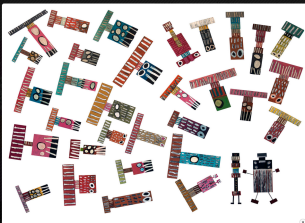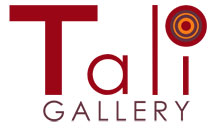Suzy Evans is a thoroughly Modern Murri !
Suzy creates innovative and thoughtful artworks in various media as well as operating her design studio.
Suzy was a finalist in Telstra in 2014 for her 3D body of artworks making a statement about the explorers’ notion of Australia being a dry, dusty, barren, hostile and empty space with a few singular extraordinary men determinedly forging on as supposed ‘heroes’.  This view was used to justify and rationalise their invasion history of conquering and seizing everything in their path which was often portrayed as if they were doing the traditional owners, the original inhabitants a favour. Â
Rachael Maza (Ilbijerri Theatre Company’s Artistic Director)Â writes: Colonisation was justified as it was ‘founded on the idea that there was a civilised, progressive people who had the right to invade and take over from and convert the lesser people – the savage.’ Â Myths that Aboriginal people died of natural causes and that there are no ‘real Aboriginal people left’ continued to be advanced in an attempt to portray colonisation as ‘somehow meant to happen…somehow part of nature’.
At worst these explorers were termed intruders although they often took land violently and with horrendous massacres.   These massacres are within the living memory of many survivors today, and certainly  known about by their children and grandchildren. Overall they are poorly documented but there is plenty of evidence to prove they occurred.

Many Australians are unaware that the settlement of Australia was illegal as it contravened International Law of the day – Aboriginal people were never offered a treaty, although Maori, Canadian and American Indians, Indians and Africans were all given one. Â Our current constitution is also in need of modification to acknowledge the rights of Aboriginal people as there are many laws which urgently require updating for all to properly recognise, respect and enjoy their rightful place.
In this body of work, Suzy makes reference to Albert Tucker’s painting of the Gomeroi clan attacking the explorer Major Mitchell (with the parrot’s beak being a metaphor for a spear), and as such, acknowledging Black Resistance which was so often overlooked in our teaching of the history of white settlement. Â Â Yet, Suzy comments, Â Tucker could have taken up the case further but chose to focus on WWII.
Paul Keating’s Redfern Speech is a powerful reminder of the consideration that needs to be given to referring to January 26th as a national day for Indigenous Australians:
Redfern Park Speech
“[I]t might help if we non-Aboriginal Australians imagined ourselves dispossessed of the land we lived on for 50 000 years, and then imagined ourselves told that it had never been ours. Imagine if ours was the oldest culture in the world and we were told that it was worthless. Imagine if we had resisted this settlement, suffered and died in the defence of our land, and then were told in history books that we had given it up without a fight. Imagine if non-Aboriginal Australians had served their country in peace and war and were then ignored in history books. Imagine if our feats on the sporting field has inspired admiration and patriotism and yet did nothing to diminish prejudice. Imagine if our spiritual life was denied and ridiculed. Imagine if we had suffered the injustice and then were blamed for it.”
Extract from the speech by Mr Paul Keating, Prime Minister of Australia, Redfern Park, 10 December 1993 at the launch of Australia’s celebration of the International Year of the World’s Indigenous People. Â (Courtesy of the Australian Museum in Sydney)
Currently Aboriginal and Torres Strait Islander people do not live as long as other Australians;  there are communities where there is no fresh drinking water available; we have an incarceration rate 14 times higher than non Indigenous Australians; and we have the highest Indigenous youth suicide rate in the world – 100 times the national average in the Kimberley and 5 times elsewhere.  It is obvious that the Government must fairly and more carefully and thoughtfully allocate much needed planning for targeted funding in their budget to address the imbalances. We also need to ensure the Constitution is free from racial discrimination and to recognise in our Constitution that Indigenous people have more than 50,000 years of history on this continent which was ‘whitewashed’ with a ‘terra nullius’ declaration to skirt the illegalities of the occupation.  Celebrating ‘Australia Day’ on the day that ‘white settlement’ occurred, must therefore be seen as insensitive – how can Aboriginal people celebrate this day when they continue to suffer such disadvantage.
Our rock art in Australia is of World Heritage importance and the age of it is extraordinary, yet many are unaware and unappreciative of its remarkable nature. We all need to pay attention and make the effort to understand as there is much to be learned and, at Tali Gallery, we are always happy to engage with visitors to the gallery to share the remarkable nature of our Aboriginal culture through the stories in the art which illustrate far reaching knowledge of the world around us. Â Aboriginal paintings explain how our resourceful and knowledgeable Indigenous people could survive in such an inhospitable and difficult environment for so very very long, when we are rarely able to survive a day. Â It is a different skill set, and certainly not an inferior one! Â Once given the opportunity, most are fascinated by the insights and start to see the world and the cultural heritage we have in Australia in a new light!
